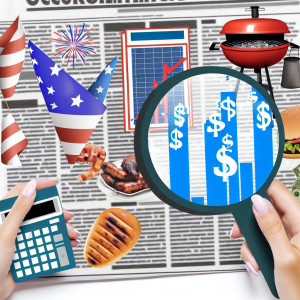As summer heats up, so do the costs of your quintessential Fourth of July cookout essentials—and savvy investors should take note. Recent data reveals a sharp surge in prices across popular barbecue staples, driven largely by tariffs and supply chain pressures, signaling broader inflationary trends that could reshape consumer behavior and market dynamics in the food and beverage sector.
A congressional report from the Joint Economic Committee’s Democratic minority arm uncovers a striking 12.7% annualized increase in the cost of a typical grocery trip for a 10-person summer cookout since President Trump’s tariff announcement in April 2018. This isn’t just a minor blip; it’s a significant acceleration in inflation that investors and advisors must factor into their outlooks.
Key highlights include a more than 13% price jump in domestic beer brands Miller Lite and Coors Light, tracked via Walmart listings and price monitoring tools like AisleGopher. Imported beers like Peroni Nastro Azzurro and Modelo Especial also saw double-digit hikes of 10.5% and 9.5%, respectively. This spike aligns closely with the 25% tariffs imposed on beer imports and aluminum cans in April, followed by a 50% tariff hike on imported aluminum in June—measures that have squeezed margins for major brewers like Constellation Brands, owner of Modelo.
But the inflation story extends beyond just beverages. Essential cookout gear is also feeling the pinch. Amazon prices for Coleman foldable camping chairs skyrocketed nearly 48%, while a 25-piece griddle accessory kit jumped 17.7%. Even staples like Banana Boat sunscreen and Reynolds Wrap aluminum foil rose by 8.1% and 6.9%, respectively. These increases reflect broader supply chain disruptions and raw material cost pressures.
What does this mean for investors and financial advisors? First, it’s a clear signal that tariff-driven inflation is permeating everyday consumer goods, which could dampen discretionary spending this summer and beyond. Investors should closely monitor companies in the food, beverage, and outdoor leisure sectors for margin pressures and pricing power dynamics. For example, brewers with strong domestic supply chains or diversified product portfolios may weather the storm better than those heavily reliant on imports.
Moreover, this trend underscores the importance of inflation-hedged investment strategies. Consider increasing exposure to sectors benefiting from pricing power or those linked to commodities that may rise with inflation, such as aluminum producers. According to a recent report from Rabobank, the cost of a 10-person barbecue is poised to hit $100 for the first time ever this year, driven largely by beef price inflation—a reminder that protein costs remain a critical inflation driver.
Advisors should also prepare clients for potential shifts in consumer behavior. Higher prices might lead to more budget-conscious spending or a pivot toward lower-cost alternatives, impacting retail and consumer discretionary earnings. Educating clients on the inflation landscape and adjusting portfolios to balance growth and inflation protection will be key.
Looking ahead, the persistence of tariffs and geopolitical tensions suggests these inflationary pressures could continue well into 2024. Investors should watch for policy developments, supply chain adaptations, and consumer sentiment shifts. Companies innovating in packaging, sourcing, or product offerings to mitigate cost pressures may present attractive investment opportunities.
In sum, this summer’s barbecue price surge is more than just a seasonal inconvenience—it’s a bellwether for inflation’s reach into everyday life and markets. Staying informed and agile will be crucial for investors aiming to capitalize on or shield against these evolving trends.
For those looking to dig deeper, keep an eye on updates from the Joint Economic Committee and Rabobank’s food inflation indices, as well as corporate earnings reports from key players like Constellation Brands and Molson Coors. The grill may be hot, but so is the opportunity for those who understand the broader financial recipe behind these price hikes.
Source: Fourth of July barbeque prices are rising, congressional analysis says

